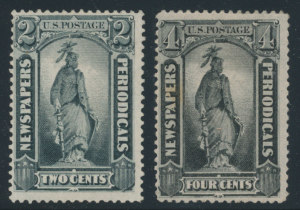During the Nineteenth century, there were two large economically developed nations that had large territories with disparate ethnic groups occupying them. One, the United States was rapidly growing west with many immigrants and local people emigrating to different areas. The other, the Austro-Hungarian Empire, had numerous ethnicities and languages under one government umbrella with much internal movement of peoples. And both Austria and the United States issued numerous Newspaper stamps so the the moving peoples could continue to stay in contact with their communities back home.
Newspaper stamps are issued for the postage carriage of periodicals, and they indicate two things-first, how much demand there is for newspapers and magazines that are printed at a distance (for, after all, most local newspapers are hand delivered or picked up by the recipient) and two, the governments commitment to subsidizing citizens connection with the papers and politics of their home. All countries let their postal services carry newspapers and periodicals. But it shows a profound desire to help people maintain their socio-political identity to have the government offer lower priced postal service for doing so. This is the service that Newspaper stamps represent.
We don’t have Newspaper stamps today. But the United States Postal service, by statute, still subsidizes the postal delivery of newspapers and magazines. For a greatly reduced postage rate, the postal service must deliver newspapers as if they were first class mail. From the earliest days of our nation, we have been committed to spreading knowledge and thought. Government doesn’t just waste money. It funds its citizen’s knowledge and schooling and roads and defense and retirement. For many years, newspapers special relationship in the post has been under attack as a wasteful subsidy. One of the things you can count on in many people’s politics-what you get from government is a wasteful extravagance. What I get is the legitimate function of government.


